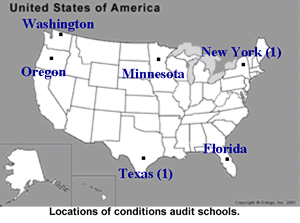
![]()
Comfort Conditions Audits
 A group of 16 “problem” schools were identified from the surveys from
which to select the schools to be audited. Problem schools were defined as
schools for which the survey respondents indicated either “many” or “chronic” complaints
last year about the indoor air temperature and indoor air quality in regular
classrooms. While it was intended that all audited schools be selected from
this problem school list, there was considerable difficulty in obtaining
cooperation from these schools and in the end, only two of the audited schools
came from the survey.
A group of 16 “problem” schools were identified from the surveys from
which to select the schools to be audited. Problem schools were defined as
schools for which the survey respondents indicated either “many” or “chronic” complaints
last year about the indoor air temperature and indoor air quality in regular
classrooms. While it was intended that all audited schools be selected from
this problem school list, there was considerable difficulty in obtaining
cooperation from these schools and in the end, only two of the audited schools
came from the survey.
Conditions audits were finally conducted in a total of eight schools in Florida, Minnesota, New York, Oregon, Texas and Washington. The audits typically included zone pressure mapping, ventilation tests, sampling and monitoring of indoor temperatures, CO 2 levels and RH, and in some cases a blower door building air tightness test.
 Significant ventilation problems were present in each of the eight audited
schools. These problems appear to be occurring due to a combination
of factors including lack of maintenance, lack of knowledge of the
systems and in some cases poor system design. It also appears that
since ventilation air problems are not easily identified unless comfort
or other conditions issues arise, they typically go unresolved. In
cases where a problem has been detected, a solution may
be provided that does not resolve the root problem(s). Bathroom and other
exhaust fan problems were also a common find in the audits where the fans
were either non functional or inadequate.
Significant ventilation problems were present in each of the eight audited
schools. These problems appear to be occurring due to a combination
of factors including lack of maintenance, lack of knowledge of the
systems and in some cases poor system design. It also appears that
since ventilation air problems are not easily identified unless comfort
or other conditions issues arise, they typically go unresolved. In
cases where a problem has been detected, a solution may
be provided that does not resolve the root problem(s). Bathroom and other
exhaust fan problems were also a common find in the audits where the fans
were either non functional or inadequate.
The audits also found high RH levels (60-70%) and several instances of low classroom temperatures (70 oF and lower) in the hot-humid climate schools. Portable dehumidifier “band aids” were commonly in use in these classrooms to help control RH levels.
